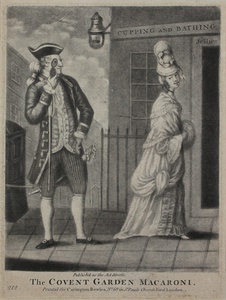| Method | Mezzotint |
| Artist | [Anonymous] |
| Published | Publish'd as the Act directs [c.1766-1799]. Printed for Carington Bowles, No. 69 in S.t Pauls Church Yard London. |
| Dimensions | Image 139 x 112 mm, Plate 153 x 113 mm |
| Notes |
A satirical social commentary on life in eighteenth century London. Set within a Covent Garden street scene, a lady, likely a prostitute, wearing a hat and carrying a muff, looks over her shoulder at a finely dressed Macaroni watching her through an eye glass. The Macaroni wears a tricorn hat, a walking stick or cane on his right wrist, and a sword. In the background left is a sedan chair, and a building outside which are signs reading "Jellies" and "CUPPING and BATHING", the later seemingly referring to a bagnio, which was originally used to name coffee houses that offered Turkish baths, but by 1740 it signified a boarding house where rooms could be hired with no questions asked, or a brothel. From the 16th century to the 18th, Covent Garden, was London's epicentre of the sex trade. Sir John Fielding, magistrate of the Bow Street Police Court, called it "the great square of Venus". The printer and publisher Carington Bowles (1724 - 1793) was the son of the printer John Bowles, to whom he was apprenticed in 1741. In 1752 until c.1762, they became a partnership known as John Bowles & Son, at the Black Horse, Cornhill, London. Carington left the partnership in order to take over the business of his uncle, Thomas Bowles II in St Paul's Churchyard. When Carington died in 1793 the business passed to his son (Henry) Carington Bowles. Carington Bowles (1790) 234, BM Satires undescribed, Lennox-Boyd i/i Condition: Slightly light impression. Date erased from end of publication line. Inscribed "212" below title to the left. Framed in a simple oak frame. |
| Framing | framed |
| Price | £300.00 |
| Stock ID | 51701 |

